Physical Address
304 North Cardinal St.
Dorchester Center, MA 02124
Physical Address
304 North Cardinal St.
Dorchester Center, MA 02124
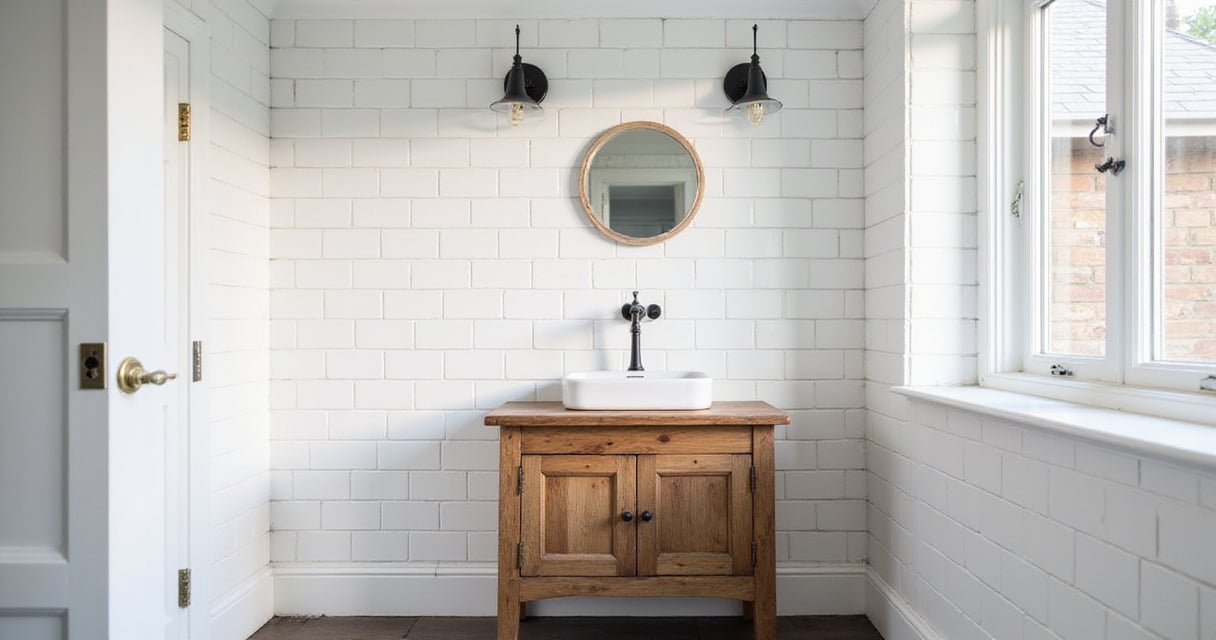
Discover 21 stunning farmhouse bathroom tile ideas that perfectly blend rustic charm with modern functionality. From classic subway tiles to wood-look porcelain, find inspiration for your dream bathroom renovation.
A bathroom is more than just a room for routines. It’s a private space, a sanctuary. In my work with Scandinavian design, we often talk about creating a sense of hygge—that feeling of deep comfort and contentment. I see a similar yearning in the North American love for the farmhouse aesthetic: a pull toward simplicity, warmth, and an honest connection to the land.
But where some see shiplap and mason jars, I see an opportunity for something more enduring. The soul of this style isn’t about decoration; it’s about a feeling. And that feeling starts from the ground up, with the tile you choose. The right tile grounds a room, both literally and emotionally. It’s not just a surface to be washed; it’s the canvas for your personal retreat. Let’s talk about how to get it right.
People sometimes ask me if subway tile is overdone. My answer is always no. A truly classic element never goes out of style; it simply becomes a foundation. It’s the white t-shirt of the design world: clean, versatile, and honest. Its origins in public transit speak to its practical, no-nonsense character, a value I deeply respect in Nordic design.
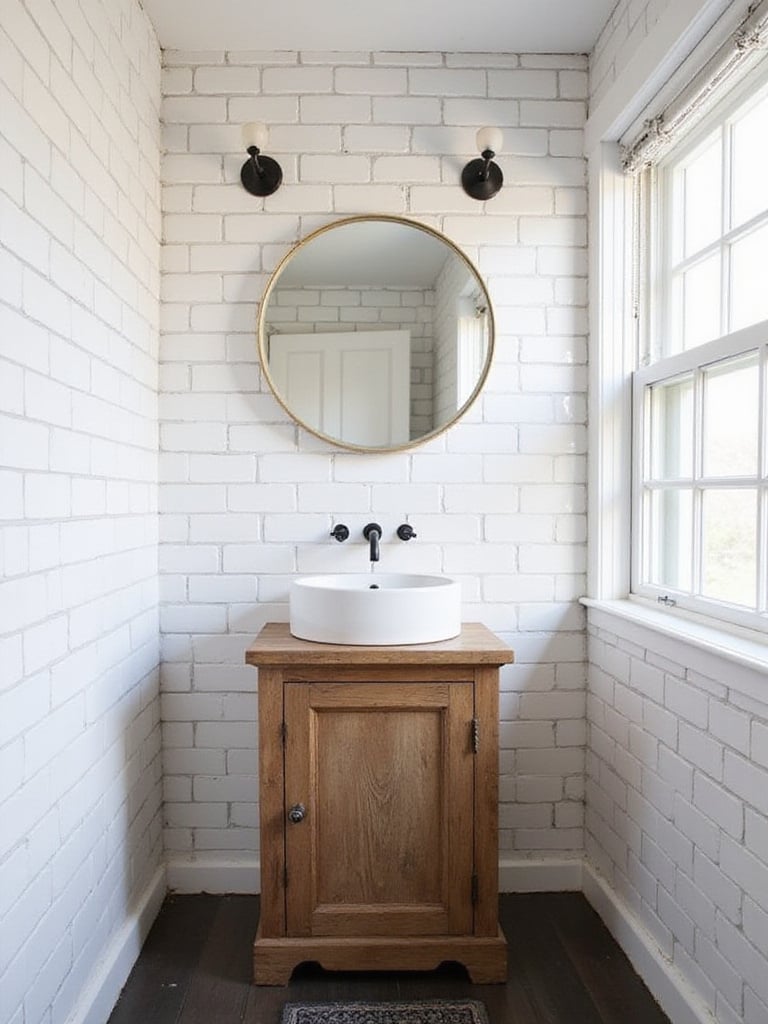
I once worked with a client who was renovating a beautiful old country house. She was afraid white subway tile would look too clinical. Instead of stark white grout, we used a soft, warm grey. The effect was immediate. It outlined each tile just enough to give the wall a subtle, handcrafted texture, not a sterile grid. It highlighted the form without shouting. What I tell my clients is this: don’t think of subway tile as the star. Think of it as the perfect, quiet backdrop that makes your beautiful wood vanity or brass taps truly sing.
From that crisp, clean look, a simple change in finish can shift the entire mood of the room.
Here’s where things get interesting. The glossy tile that’s so common is designed to reflect light, to be bright and slick. A matte finish does the opposite. It absorbs light, creating a softness that feels incredibly calming and natural. It reminds me of the diffuse light on a cloudy Scandinavian afternoon—no harsh glares, just a peaceful, even glow.
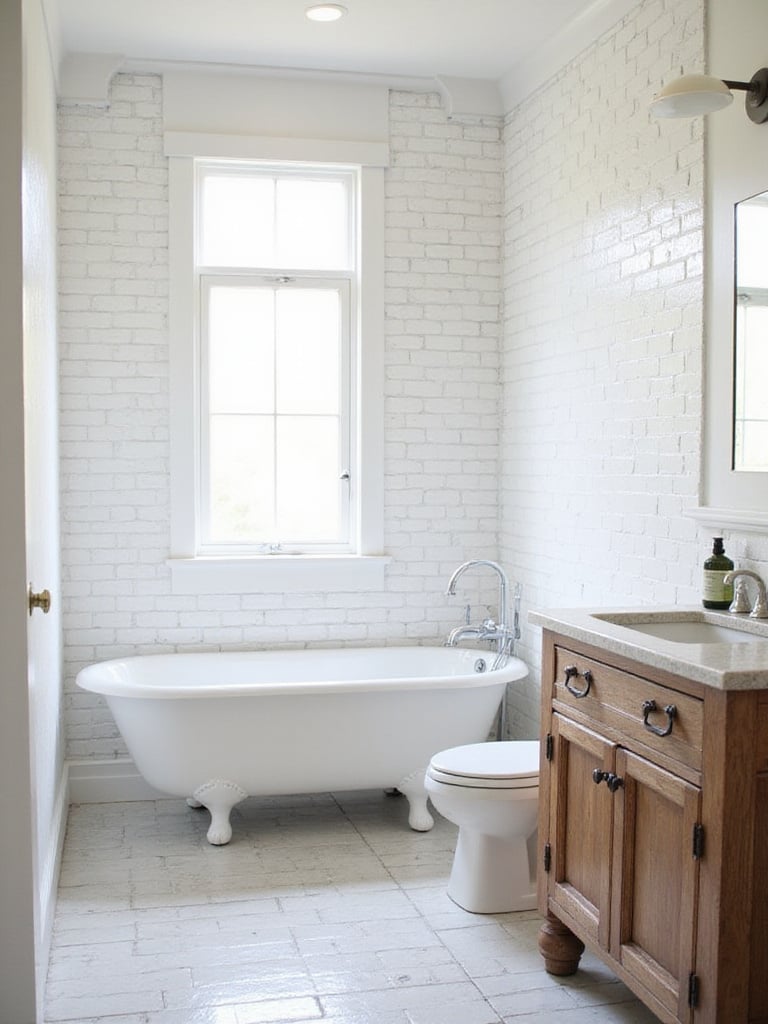
A matte surface has a certain quiet confidence. It doesn’t need to be shiny to be beautiful. It complements the texture of raw wood or the patina of vintage fixtures perfectly, lending a sense of age and authenticity to a new space. In my experience with integrating natural elements, the texture is just as important as the color. Running your hand over a matte tile wall feels more like touching stone than ceramic. And on the floor, that lack of gloss gives you a bit more grip underfoot, which is never a bad thing in a wet environment. It’s a small choice that makes a huge difference in the room’s overall feel.
The real magic, though, happens when you start playing with the lines between the tiles.
Using a dark grout with a light tile is more than just a style choice; it’s a statement about appreciating form. It’s like a line drawing. You’re celebrating the simple, humble shape of the rectangle and the honest grid of the pattern. In a minimalist space, where every element has to count, this is a brilliant way to add graphic interest without adding clutter.
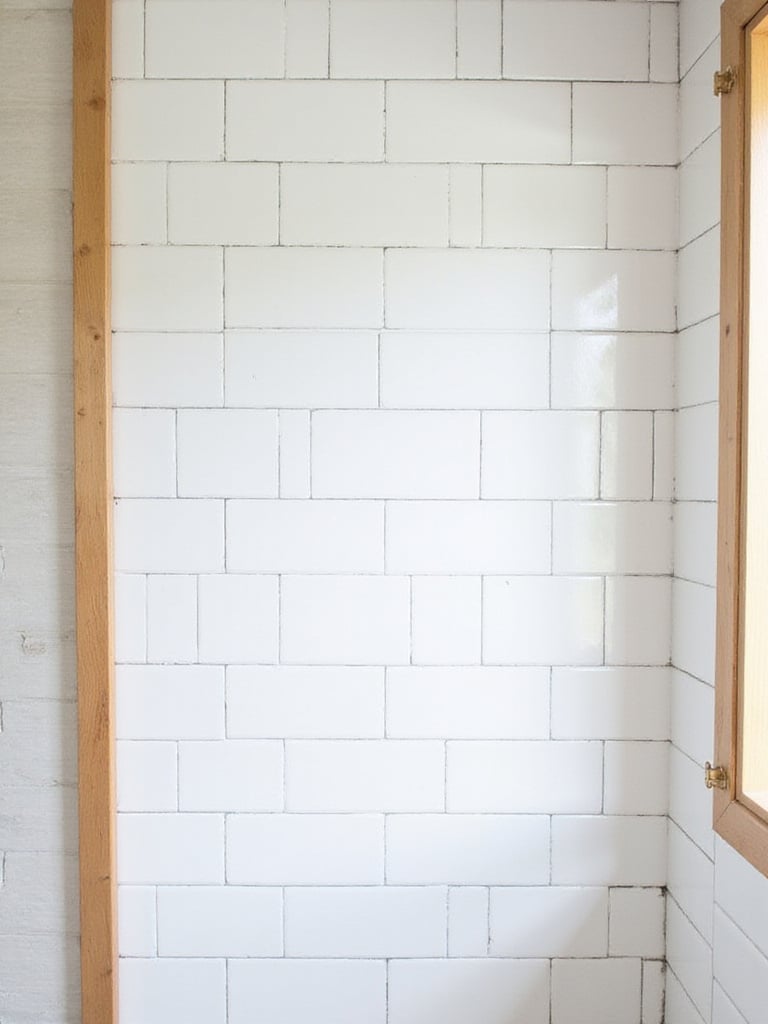
A few years ago, for a project in a compact city apartment bathroom, we used classic white subway tiles but with a dark charcoal grout. The owner was worried it would look too busy. But the result was the opposite. It made the walls recede and gave the small room incredible depth. What I’ve learned from years of focusing on functional minimalism is that strong, clean lines actually create a sense of order and calm. The grout becomes part of the design itself, accounting for a surprising amount of the wall’s visual real estate. It’s a detail, but it’s one that defines the entire character of the surface.
Now, let’s take that idea of clean, repeating lines from the walls down to the floor.
There is a simple, fundamental beauty in the hexagon. You see it in honeycombs and basalt columns. It’s a shape from nature, and bringing it into the home connects us to that organic order. Hexagon tiles have been around for over a century, which is why they feel so at home in a farmhouse-inspired space. They feel familiar and enduring, not trendy.

I learned this the hard way on an early project: always start your tile layout from the most visible point in the room—usually the doorway. If you start against a crooked wall, the entire pattern will look off by the time you reach the middle of the floor. For a truly classic look, I favor small, one-or-two-inch matte white hex tiles. They create a beautiful, textural pattern underfoot that feels wonderful on bare feet. A friend of mine has them in his 100-year-old Stockholm apartment, and they look as right today as they did a century ago. That’s the definition of timeless.
From one classic small tile to another, let’s look at a shape with an even more distinct, charming character.
Penny tiles have an undeniable charm. They feel playful and historic at the same time. The dense, dotted pattern they create offers a unique kind of visual texture that’s detailed without being overly ornate. It’s a perfect fit for a style that values both simplicity and character.
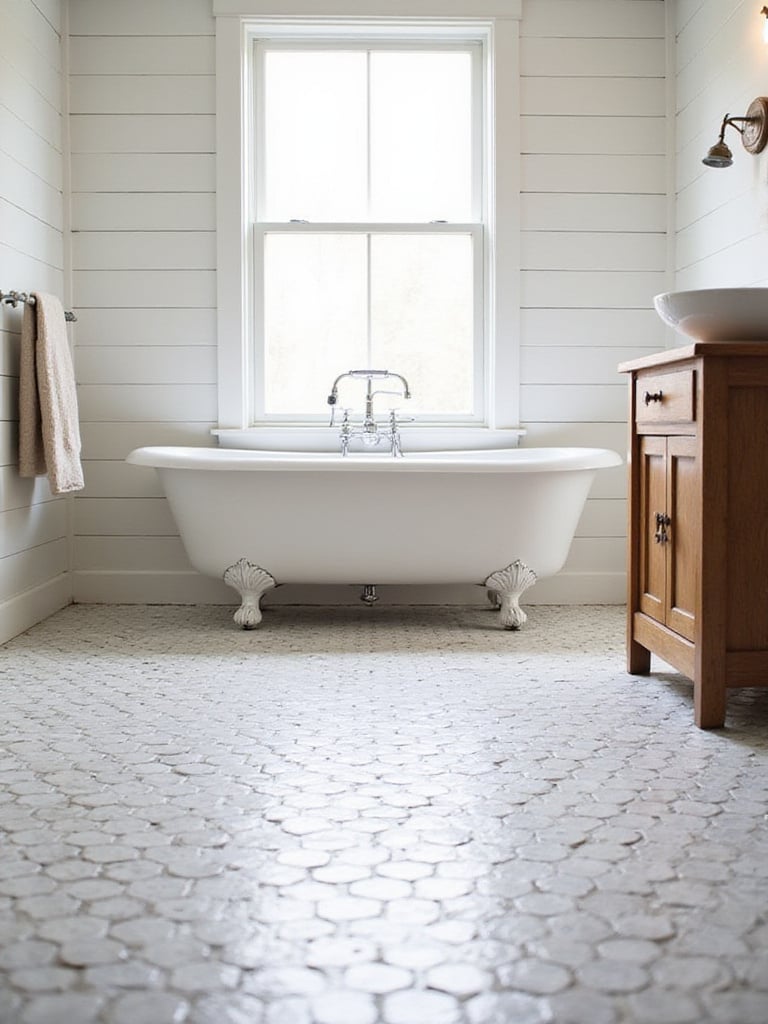
But let’s be honest. All those tiny tiles mean one thing: a lot of Grout Lines. And grout is porous. What I always tell my clients is that if you choose penny tile, you must commit to sealing the grout properly after installation, and probably re-sealing it every year or so. It’s not a huge job, but it’s essential to prevent staining and mildew. With a good quality epoxy grout and regular care, they are fantastic. The upside is that all those grout lines provide excellent slip resistance, making them one of the safest choices for a shower floor.
Now, let’s talk about achieving warmth underfoot, but with a more modern approach.
As someone who loves natural materials, I have a deep appreciation for the beauty of wood. But putting real hardwood in a full bathroom? Frankly, it’s a terrible idea. It’s a constant battle against moisture, warping, and rot. This is where modern technology offers a truly brilliant solution. Wood-look porcelain tile has become so convincing that it often takes a second look—or touch—to know it’s not real timber.

In my work with sustainable design, longevity is paramount. Choosing a material that will last for decades without needing replacement is the most sustainable choice you can make. I once had to oversee the replacement of a real-wood bathroom floor that had completely failed after just five years. The client was heartbroken. In the new design, we used a porcelain plank that mimicked a pale, weathered oak. The look was perfect, the warmth was there, and the client now has a beautiful floor that is completely impervious to water. It’s the ideal marriage of hygge and pure, simple function.
From the convincing look of wood, we can move to another material that brings the outdoors in.
Connecting our homes to the landscape is a core tenet of Scandinavian design. We love our stone, our slate, our granite. But like wood, real stone in a bathroom can be demanding. It’s porous, requires regular sealing, and can be easily stained by soaps or cleaning products.
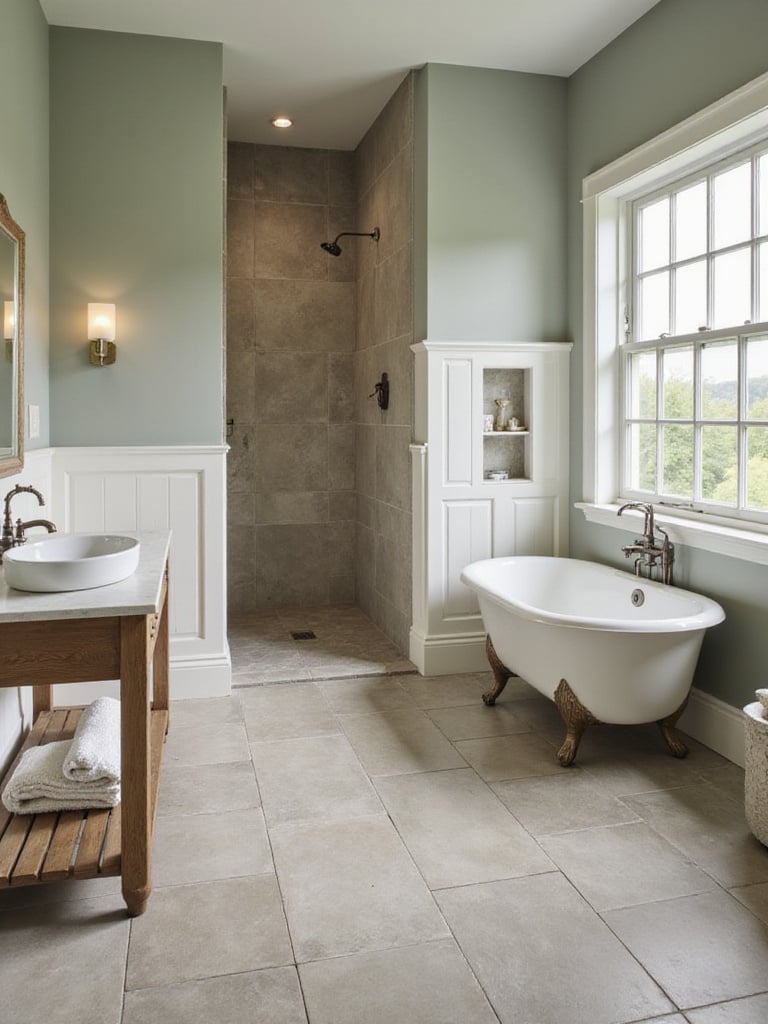
High-quality porcelain that replicates the look of natural stone gives you that earthy, organic feeling without the high maintenance. I’ve noticed that the key to getting this right is the variation. Look for a tile with a “V3” or “V4” rating. This means the pattern and color vary significantly from tile to tile, just as they would in a real stone quarry. This prevents the “repeating pattern” effect that can make a tile floor look artificial. A floor of large-format, slate-look porcelain tiles can make a bathroom feel like a serene, stone-lined cavern—a perfect escape.
Let’s stay with that raw, natural feel, but explore a material with even more rugged texture.
Exposed brick has a history and a soul to it. In a bathroom, it can add immense warmth and a sense of permanence. Using real brick, however, is a messy, heavy, and impractical proposition. It’s porous and will soak up moisture.
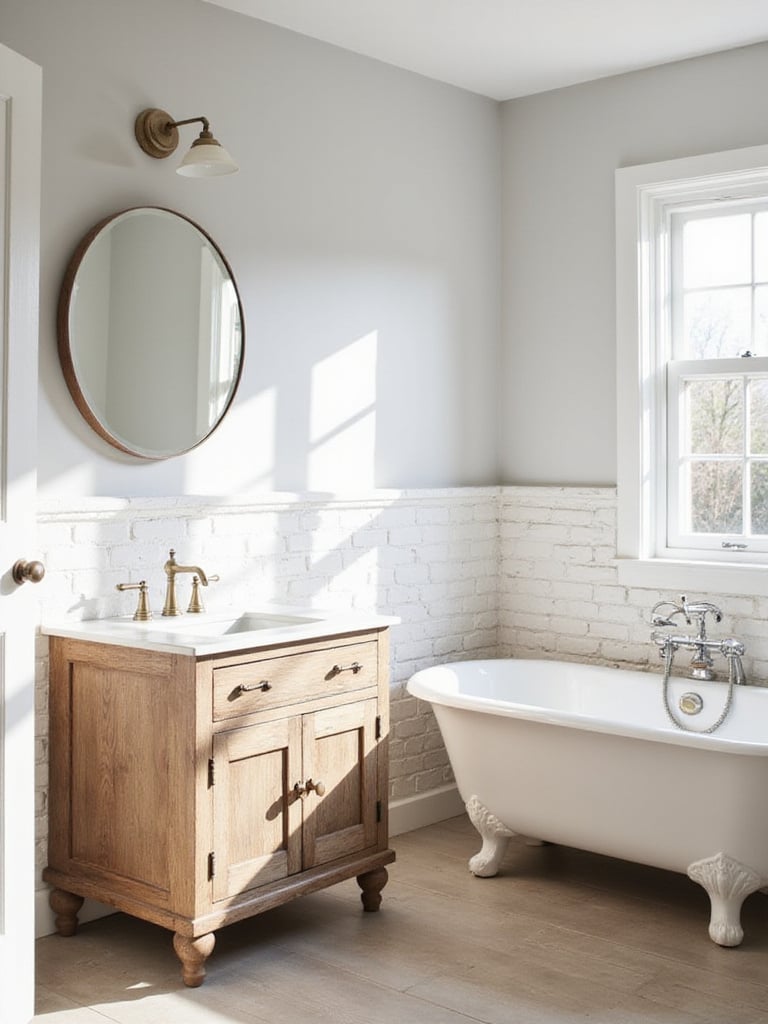
This is where thin, brick-look tiles are so useful. They capture that rustic, slightly industrial character without any of the structural or moisture-related headaches. What I advise my clients, however, is to use it with restraint. A full wall of faux red brick can feel heavy and a bit dated. Think of it as a textural accent. Perhaps behind the vanity, or even inside the shower niche. I particularly love the look of brick-look tile that has been painted over in a soft white or warm grey. You get all of that beautiful, rugged texture, but in a way that feels bright, clean, and perfectly suited to a serene bathroom space.
From the structured texture of brick, we can shift to something with a more organic, handmade charm.
There is something beautiful in imperfection. Zellige tiles, with their Moroccan roots, celebrate this. Each tile is slightly different—in color, in flatness, in its crisp edges. When installed, these subtle variations create a surface that is alive. It catches and reflects light in a thousand different ways, creating a dynamic, shimmering effect that a machine-made tile simply cannot replicate.
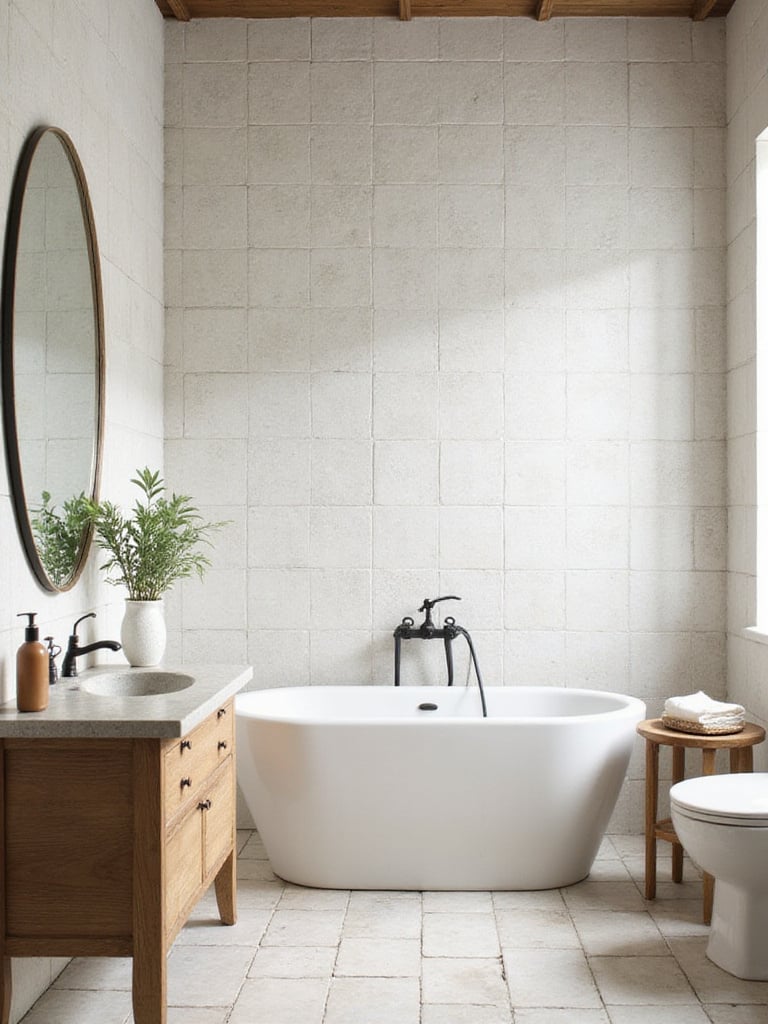
This embrace of the “perfectly imperfect” aligns so beautifully with the principles of hygge. It feels human. It has a story. I’ve seen these tiles used for a shower surround, and the result is breathtaking. It feels like being inside a watercolor painting. However, here’s the honest part: they are tricky to install. The unevenness that makes them beautiful also makes them a challenge for the tiler. It’s not a job for a beginner. But if you’re willing to invest in a skilled installation, the result is a truly unique, artful surface.
From these small, character-filled tiles, let’s jump to the other end of the spectrum.
Sometimes, the most calming thing you can do for a space is to simplify it. Large format tiles—anything over 15 or 24 inches on one side—are masters of simplification. The most immediate benefit? Fewer grout lines. This is huge. Grout lines create a visual grid that can make a small bathroom feel busy and confined.
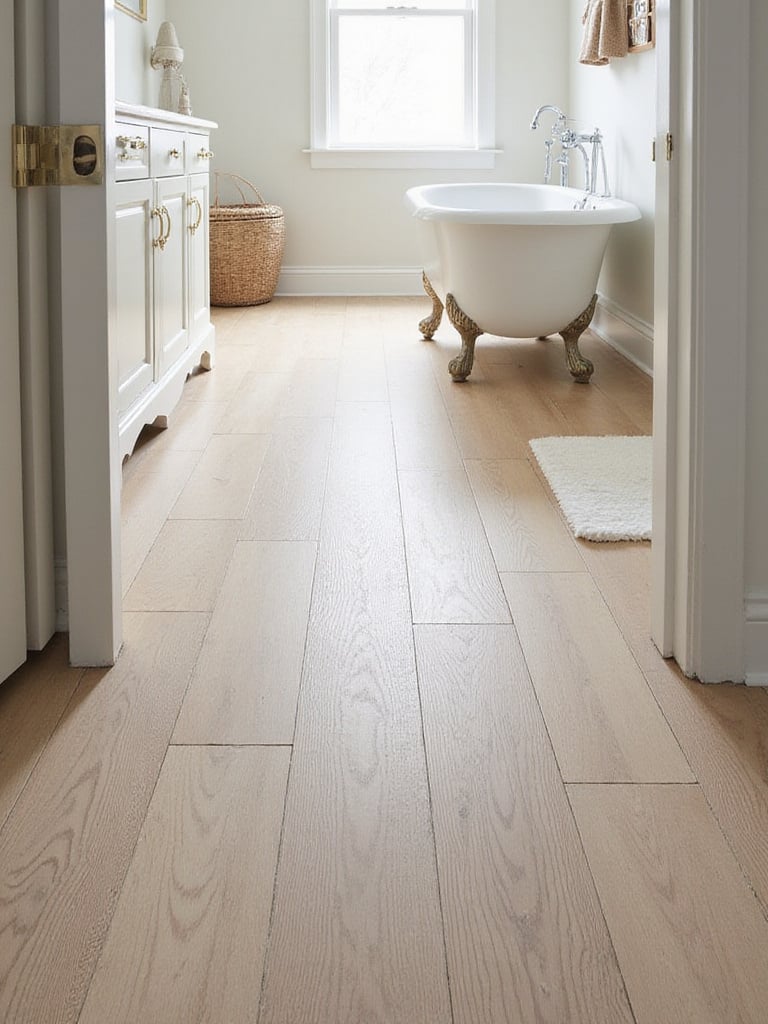
By reducing the number of lines, you create a more seamless, expansive surface. The floor becomes a quiet, uninterrupted plane, which makes the entire room feel larger and more serene. From my perspective in functional minimalism, fewer grout lines also means less to clean. It’s a practical win that leads to a cleaner aesthetic. A floor of large, soft-grey, stone-look porcelain tile creates a foundation of pure calm. It doesn’t demand attention; it just provides a perfect, solid ground for everything else in the room.
But what if you want to add just a small, carefully chosen detail?
While large tiles create calm, small tiles can introduce personality. The key word here is accent. Using intricate tile everywhere can quickly become overwhelming, but a small, focused application is like adding a beautiful piece of jewelry to a simple outfit.
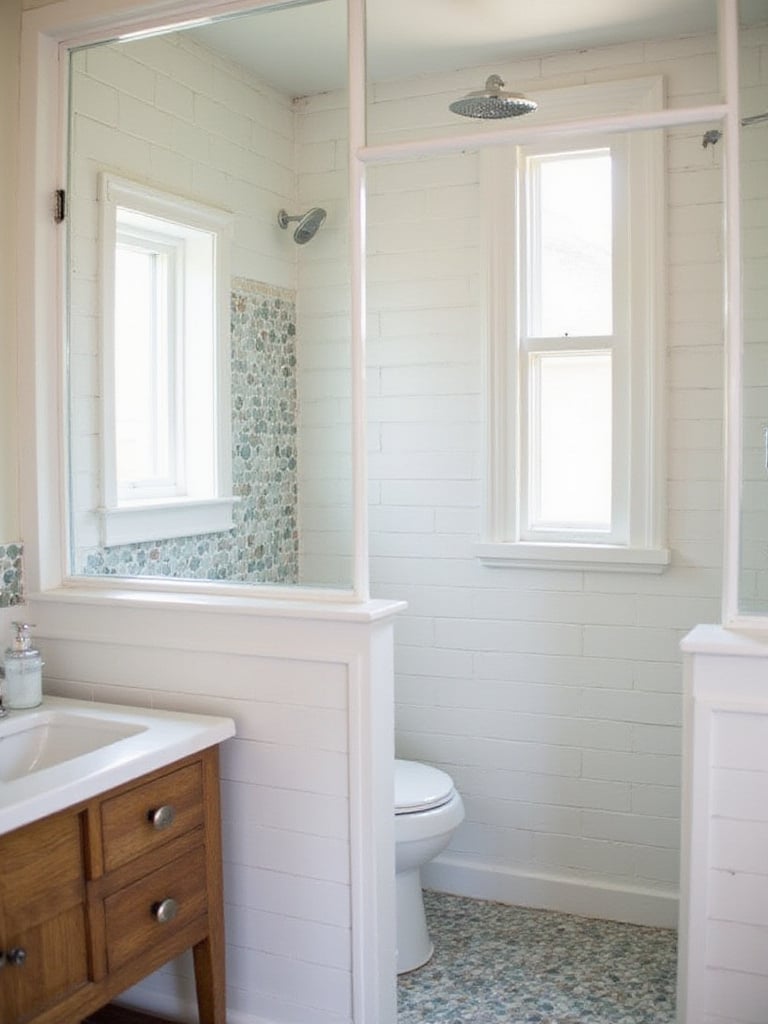
Think about a recessed shower niche. Lining it with a beautiful, small-scale patterned tile turns a simple storage spot into a jewel-box focal point. Or consider a simple, single-line border of a contrasting tile running horizontally around the room at chair-rail height. It breaks up the wall and adds a subtle, custom detail. What I’ve seen play out in so many projects is that restraint is what makes these moments powerful. You’re creating a small “aha” moment for the eye, a little reward for looking closer. It’s not about shouting; it’s about whispering.
Now, let’s dive into color and how it sets the tone for the entire room.
Grey is the color of stone, of winter skies, of weathered wood. It’s a color deeply rooted in the natural Nordic palette, and it’s incredibly versatile. A soft grey provides a neutral foundation that is calming and sophisticated, but without the potential coldness of a stark white. It’s a chameleon—it can feel cool and crisp or warm and enveloping, depending on the light and the other materials in the room.
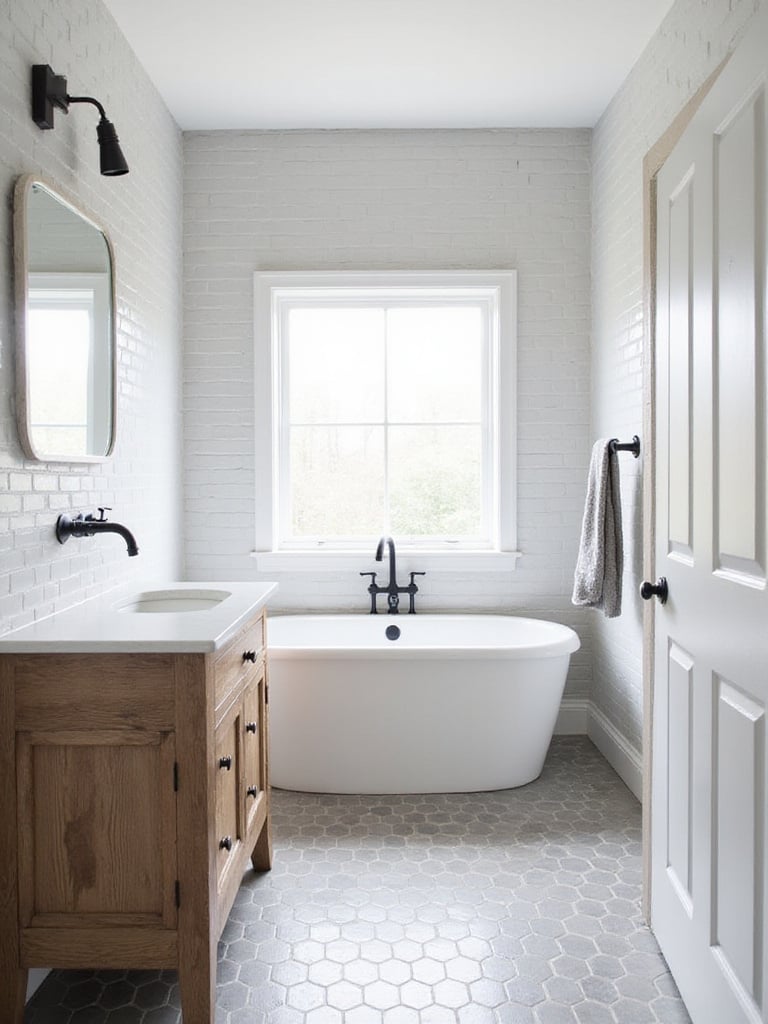
My years of designing spaces in Scandinavia have taught me to appreciate the nuance in grey. It’s not one color, but an entire family. A light dove grey with a matte finish can make a small bathroom feel airy and open. A deeper charcoal slate can create a dramatic, cozy feeling, especially when paired with warm woods like oak or teak. If you’re struggling to choose a color, soft grey is an almost foolproof starting point. It’s calm, it’s timeless, and it allows other elements, like a beautiful plant or a set of colorful towels, to provide the accent.
If grey feels too cool, its warmer cousin offers a different kind of comfort.
Bright, sterile white can feel a bit clinical. But the moment you introduce a hint of cream, beige, or yellow, the entire feeling changes. You get warmth. Creamy, off-white tiles are the cornerstone of a cozy, inviting space. They reflect light beautifully, helping a room feel bright and open, but the underlying warmth keeps it from feeling stark.
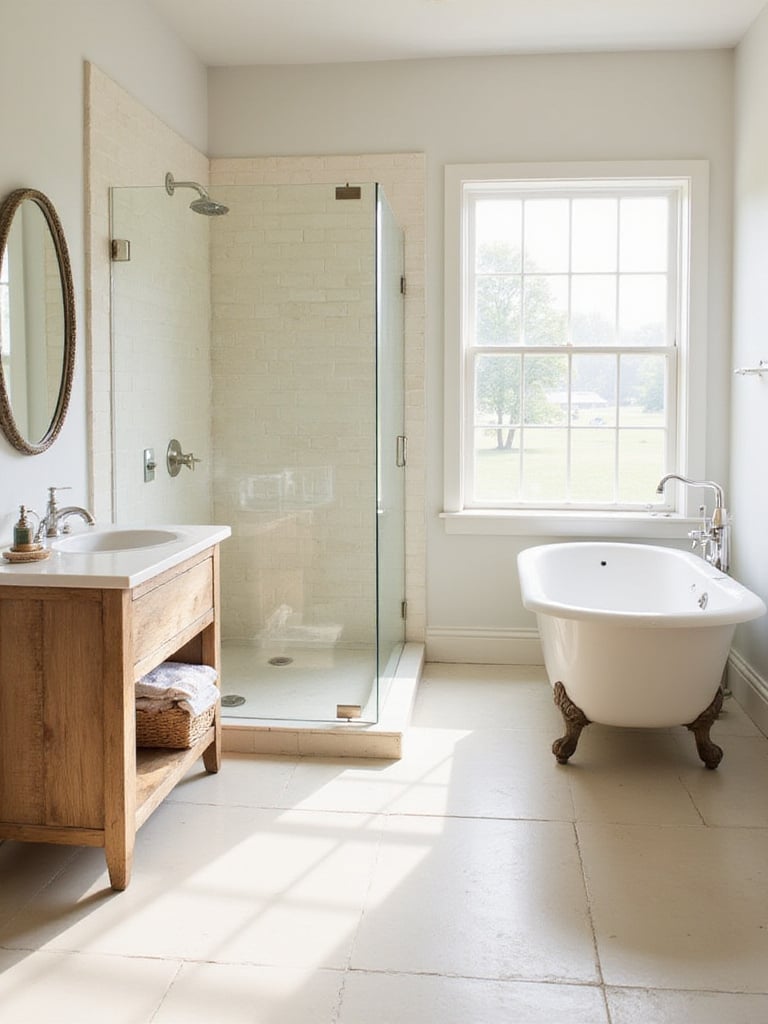
This is pure hygge. It’s the color of sheep’s wool, of unbleached linen, of warm milk. It pairs beautifully with any natural wood tone, from pale pine to rich walnut. What I often suggest is to look for an off-white tile with a slightly irregular edge or a handmade-look finish. This slight imperfection, combined with the warm color, creates a surface that feels instantly comfortable and lived-in, not like a sterile showroom. It’s a subtle shift from pure white, but it has a massive impact on the cozy factor of the room.
But comfort doesn’t always have to be neutral. A bit of depth can be powerful.
In a palette that’s often dominated by light neutrals, a deep, rich navy blue can be a stunning anchor. It’s the color of a deep fjord or a Nordic night sky. It adds a seriousness and a sophistication that is incredibly powerful. The key is to use it strategically, not everywhere.
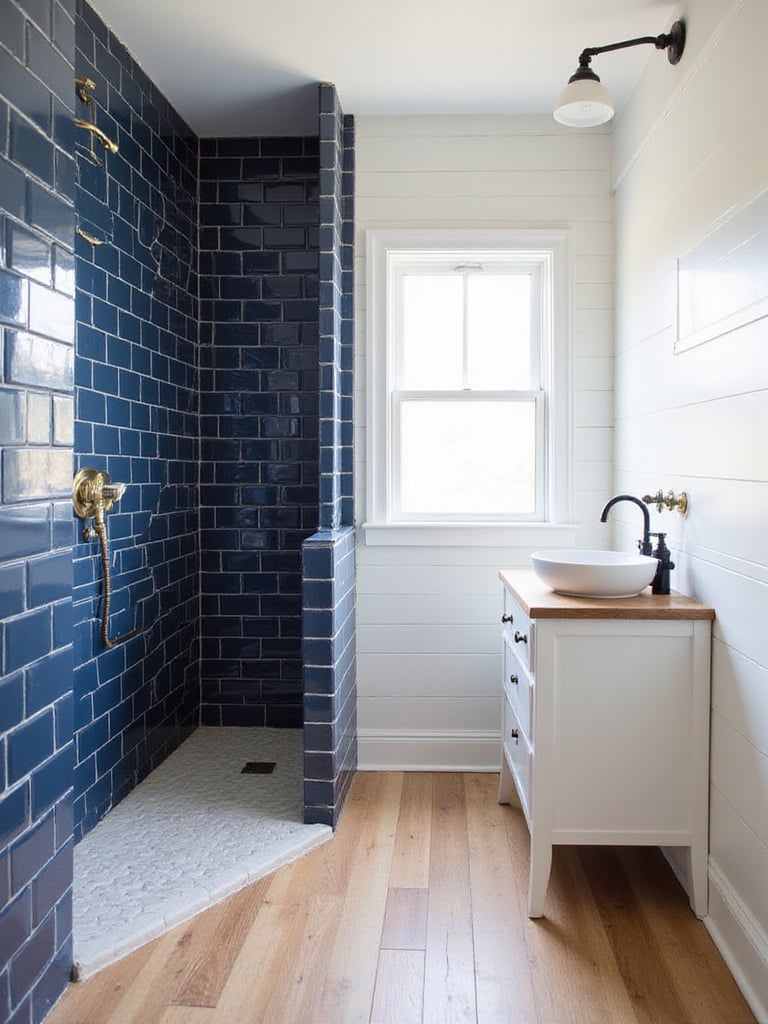
A shower completely tiled in glossy navy subway tile can be breathtaking, especially when contrasted with bright brass fixtures. It feels dramatic and enveloping, like a private grotto. Or, for a more measured approach, a floor of navy hexagon tiles can ground the entire room, providing a solid foundation for lighter walls and fixtures. I’ve seen this play out when clients are afraid of dark colors; they worry it will make the room small. In fact, a dark, rich color used thoughtfully can create an illusion of depth, making the space feel more curated and complex.
From the deep blue sea, let’s turn to the forest for our next color inspiration.
Green is the color of life, of calm, of nature. Bringing it into the bathroom is one of the easiest ways to create a restorative, peaceful atmosphere. But the shade of green is critical. For a farmhouse or Scandinavian-inspired space, I would steer clear of bright, artificial lime or kelly greens.
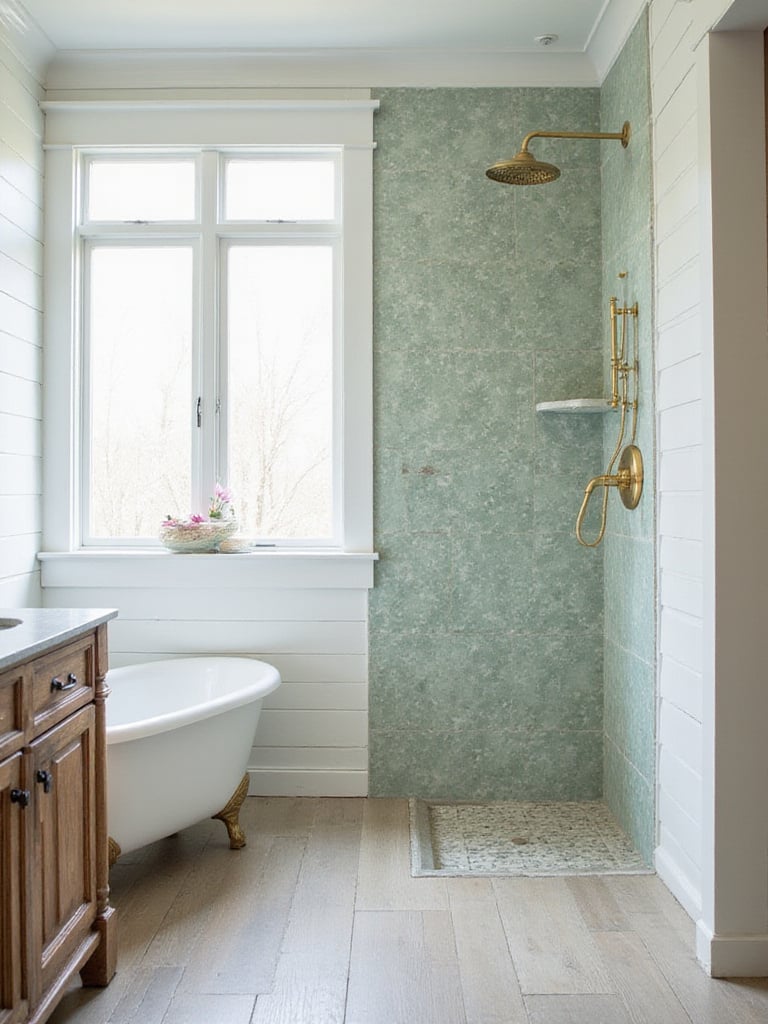
Instead, look to the tones you’d find in a forest. A soft sage green, a muted moss, a dusty olive, or even a deep forest green. These shades have an earthy, organic quality that feels grounding and serene. I recently designed a bathroom where we used a sage green subway tile in a herringbone pattern for the entire back wall of the shower. Paired with a simple oak vanity, the effect was like standing in a quiet, misty woodland. It’s color, yes, but it’s color that feels like a neutral drawn straight from the natural world.
From the harmony of single colors, let’s explore a classic, high-impact combination.
There is nothing more timeless or confident than a black and white palette. It’s graphic, it’s clean, and it has a historical weight that works beautifully in a modern farmhouse context. A classic checkerboard floor, for instance, is instantly nostalgic but can be made to feel modern with larger tiles or a honed finish.

What really excites me about black and white is how it provides a strong, graphic foundation that allows warm, natural textures to shine. Imagine a black and white hexagon mosaic floor. On its own, it could feel stark. But add a reclaimed wood vanity, some warm brass lighting, and a few linen towels, and the space suddenly feels balanced, warm, and full of character. The bold contrast of the floor actually highlights the softness and texture of the other elements. It’s a design partnership where each element makes the other stronger.
Pattern doesn’t always have to be so bold, of course. It can be much more subtle.
A patterned floor can bring so much personality to a bathroom, but it’s easy to get wrong. The key is subtlety. In a farmhouse context, you’re not looking for a loud, vibrant Moroccan pattern. You’re looking for something with a quieter, almost historic voice.
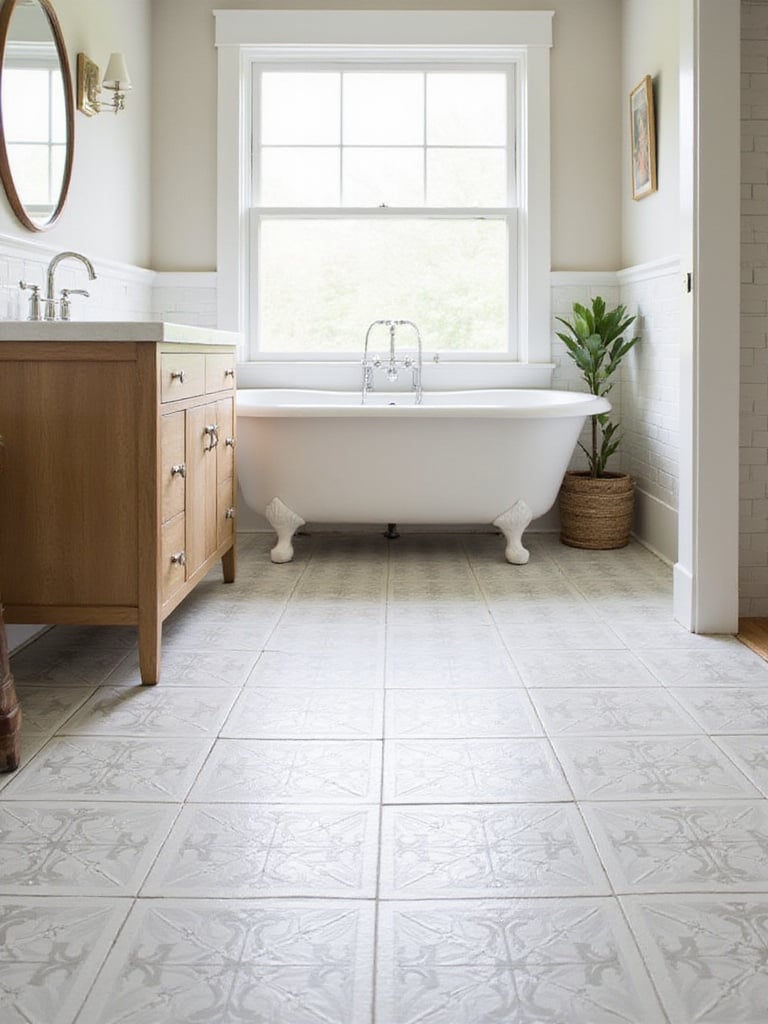
Think of porcelain tiles that mimic the look of old encaustic cement tiles, but in muted tones—soft greys, dusty blues, or even a simple black and cream. The patterns should be geometric or based on simplified natural motifs, like a star or a stylized leaf. The goal is to add a layer of interest that you might not even notice at first glance. It provides texture and a sense of history that a solid-colored floor can lack, making the room feel more curated and personal without shouting for attention.
So what happens when you combine these different shapes and patterns in one space?
Combining different tile shapes is an excellent way to add custom detail and define different zones within the bathroom. One of my favorite, can’t-miss pairings is subway tile on the walls and hexagon tile on the floor. It just works. The clean, linear grid of the subway tile provides a sense of order, while the geometric pattern of the hex tile adds a layer of interest underfoot.
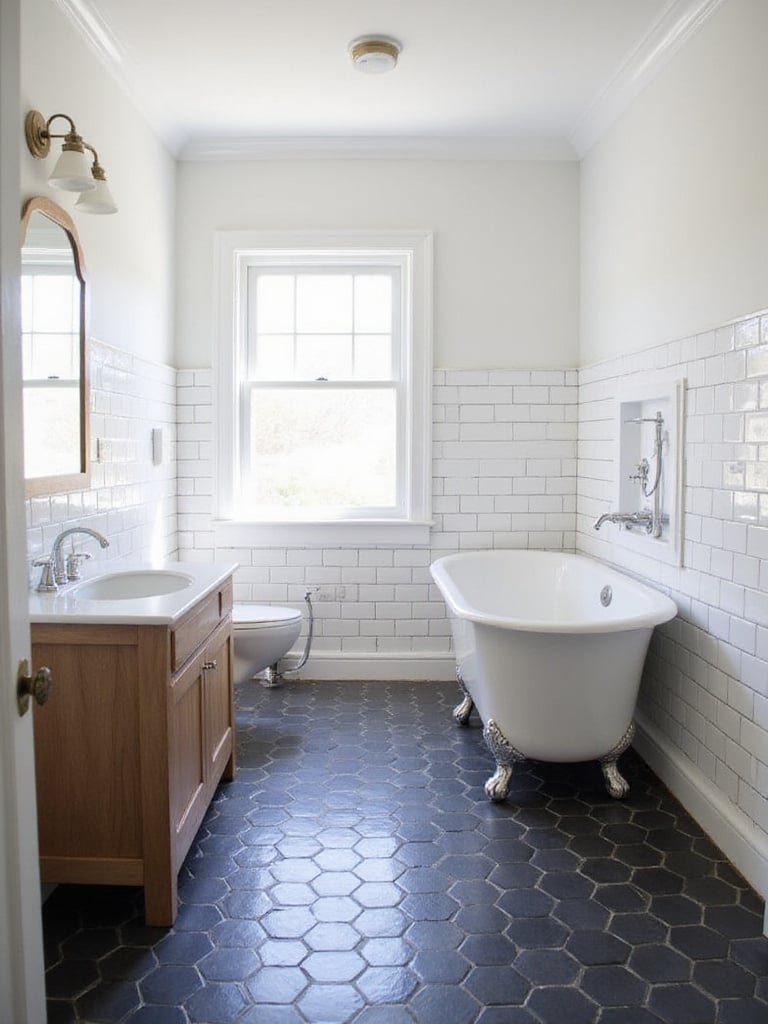
The rule of thumb I give my clients is to let one tile be the “star” and the other be the “supporter.” For instance, you could use a simple white subway tile on the walls to create a quiet backdrop, and then choose a more dynamic black hexagon or a patterned tile for the floor. Or you could reverse it: keep the floor simple with large-format grey tiles and use a beautiful, textured Zellige-style tile in the shower. By creating this contrast in shape and texture, you build a room that has depth and character, feeling layered and thoughtfully designed.
But a design is only as good as its execution, which brings us to the small details.
Trim is the full stop at the end of a design sentence. It’s a small detail that makes the difference between a project that looks “finished” and one that looks “professionally finished.” A tile wall that just ends at the edge of a shower can look abrupt. But add a simple, clean bullnose or pencil-liner trim piece, and suddenly it looks intentional and complete.
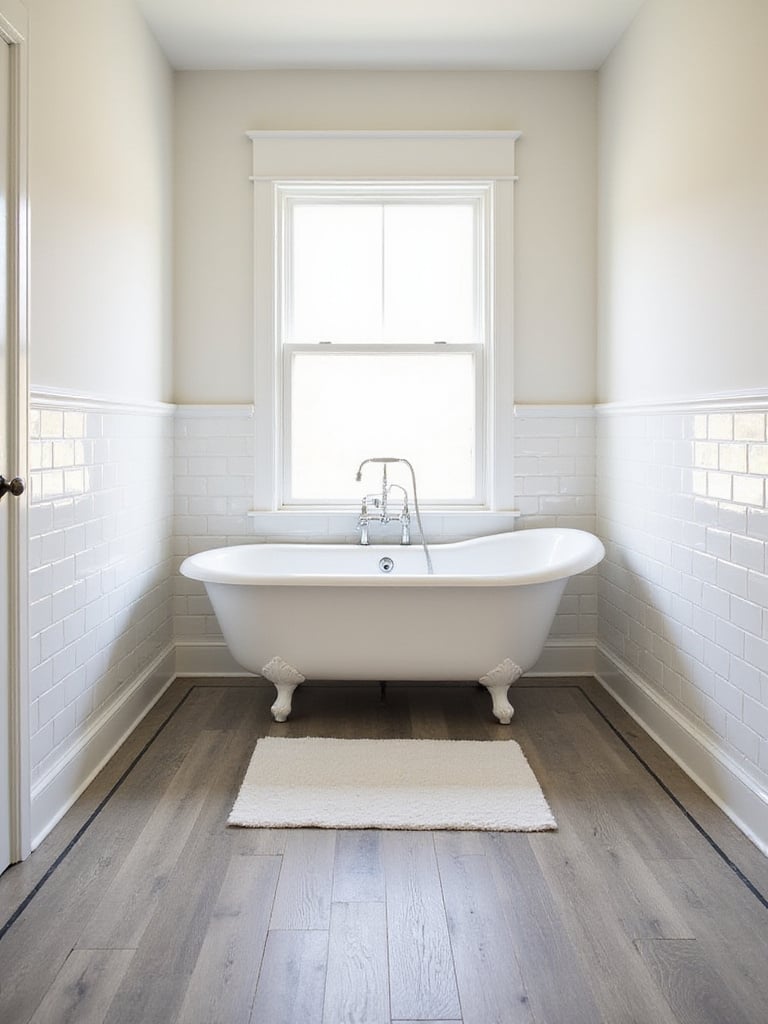
In a farmhouse style, the trim can echo traditional architectural elements. A chair-rail style trim piece capping a wainscoting of tile, for example, adds a lovely, historic detail. These pieces aren’t just decorative; they are functional. They protect the vulnerable edges of the tile from chipping and create a clean transition to a painted wall. Don’t skip this step. It’s these finishing touches that truly elevate the space.
Trim helps define edges, but tile itself can be used to define entire areas.
Using one tile for the shower and another for the main bathroom floor is not only visually interesting, but it’s also incredibly practical. It’s a clear way to delineate the “wet zone” from the “dry zone.” This simple visual separation can make even a small bathroom feel more organized and thoughtfully laid out.
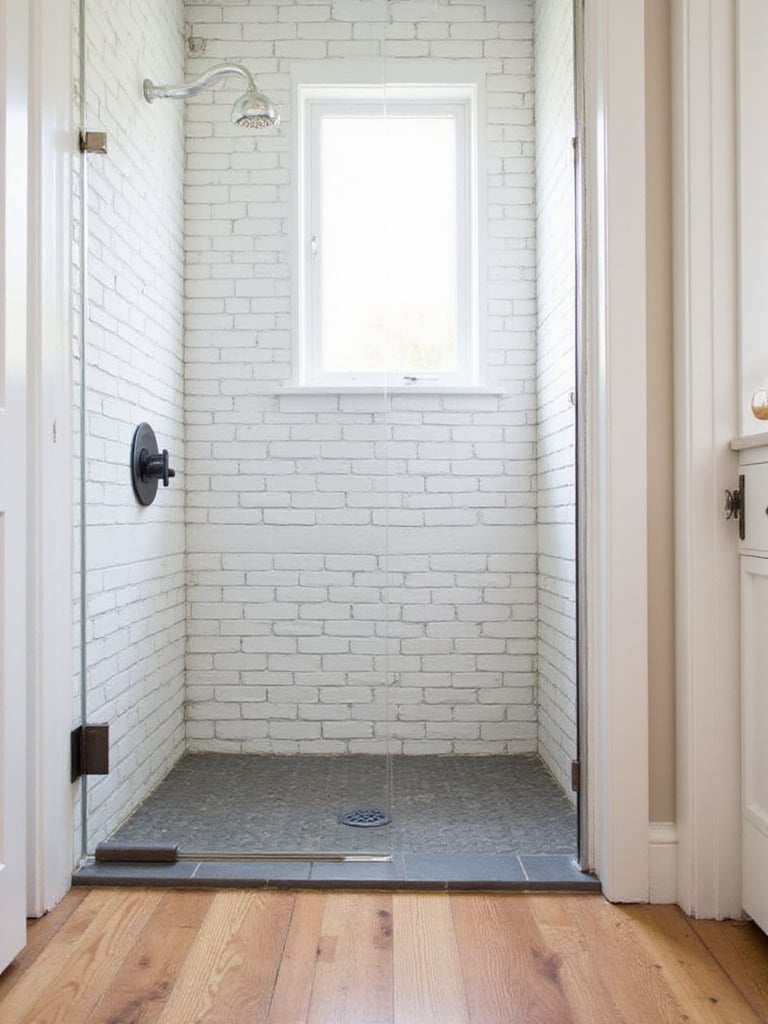
This is a chance to play with texture and material in a functional way. I love the look of warm, wood-look porcelain planks on the main floor, creating a cozy feeling when you first step into the room. Then, stepping into the shower, the floor might transition to a smaller, more slip-resistant penny or hexagon tile. On the shower walls, a simple, easy-to-clean ceramic tile makes perfect sense. This approach creates a layered, custom look that feels both authentic and highly practical.
Finally, let’s talk about a detail that can bring almost any of these ideas to life.
We’ve talked about color and shape, but texture is the sense that is often forgotten. A flat, glossy wall can feel cold. But a wall with a subtle texture invites touch and adds a layer of visual warmth. Today’s ceramic tiles can be manufactured with incredible surface textures that mimic other materials.

Beyond the wood and stone looks we’ve discussed, you can now find tiles with a linen or fabric-like texture. Imagine a shower wall tiled in a large-format tile that looks and feels like soft, woven linen. It introduces an unexpected softness and dimension to a space that is full of hard surfaces. In my experience with Nordic design, this tactile quality is essential for creating a comfortable, human-centered space. The texture catches the light in a gentle way and makes the entire room feel more established and full of character.
Ultimately, the goal is to create a bathroom that serves you—a space that feels like a genuine retreat. The beauty of the modern farmhouse ethos is its flexibility. You can lean into its rustic roots or you can pare it back to its clean, minimalist essentials, which is where it overlaps so beautifully with Scandinavian design.
Don’t get too caught up in trends. Instead, focus on materials that feel honest, on colors that bring you a sense of calm, and on textures that feel good to the touch. The most successful spaces I’ve designed are the ones where practical needs are met with a quiet, personal beauty. Build a room that brings you joy every single day. That’s a design that will last.